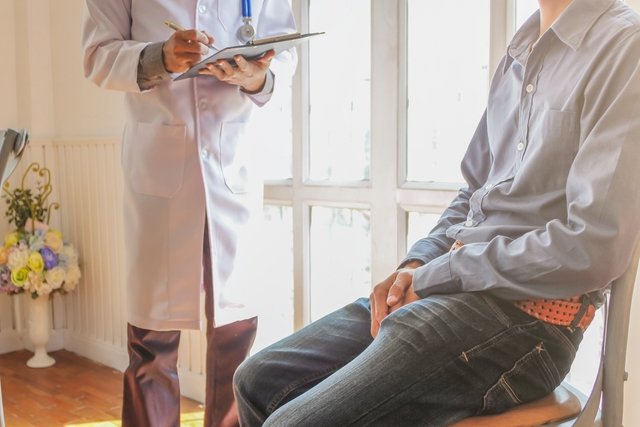Swelling in the testicle can be caused by an inguinal hernia, which occurs when the intestine exits through a weak point in the abdominal muscles and enters the scrotum, but it can also occur due to torsion of the testicle, epididymitis, varicocele, or even breast cancer. testicle.
Depending on its cause, swelling in the testicle may be accompanied by other symptoms such as pain or discomfort, a feeling of heaviness or pressure in the scrotum, the presence of blood in the semen, fever or pain when urinating, for example.
In the presence of swelling in the testicle, it is important to consult a urologist, so that its characteristics and associated symptoms can be assessed, so that the cause can be identified and the most appropriate treatment can be initiated.

Main causes
The main causes of swollen testicles are:
1. Inguinal hernia
An inguinal hernia occurs when part of the intestine exits through a weak point in the abdominal muscles and enters the scrotum, which contains the testicles, causing severe swelling that worsens when getting up from a chair or bending the body forward, and sudden pain when exerting pressure. or exercising, or feeling of pressure in the scrotum, for example.
Although inguinal hernia is more common in children and young adults, it can happen at any age.
What to do: It is recommended to consult a surgeon, who will evaluate the hernia, to decide whether surgery is necessary to place the intestine in the correct location. Therefore, whenever you suspect an inguinal hernia, it is recommended to go to the hospital as soon as possible, as there is a risk of serious complications such as infection and death of intestinal cells. Find out how surgery for inguinal hernia is performed and what recovery is like.
2. Varicocele
Varicocele is a dilation of the testicular veins, very similar to what happens with varicose veins in the legs, which can cause blood to accumulate in the region and swelling in the testicles, more frequently in the upper part, being the most common cause of male infertility.
This type of change is most common in the left testicle and is normally not accompanied by other symptoms, although some men may feel a sensation of discomfort, pain, heaviness or heat in the scrotum region.
What to do: generally no treatment is necessary, however, if there is pain it is important to go to the hospital or consult a urologist to start treatment with painkillers, such as paracetamol or ibuprofen. In addition, the doctor may also recommend the use of special, tighter underwear to support the testicles, and in some cases it may be necessary to perform surgery. Learn more about varicocele treatment.
3. Epididimite
Epididymitis is inflammation of the epididymis, which is a small duct that connects the vas deferens to the testicle, responsible for collecting and storing sperm produced by the testicle.
When inflammation of the epididymis occurs, a small lump may appear on the top of the testicle, in addition to other symptoms such as a feeling of pressure on the testicle, intense pain in the scrotal or pelvic region, or even the presence of blood in the semen.
Epididymitis is usually caused by a sexually transmitted infection (STI), such as gonorrhea or chlamydia, transmitted through unprotected anal sex, but it can also arise due to other infections, such as urinary tract infection, tuberculosis or prostatitis, for example.
What to do: epididymitis needs to be treated with the use of antibiotics and it is therefore necessary to consult a urologist if this infection is suspected. Antibiotic treatment usually includes an injection of ceftriaxone followed by 10 days of oral antibiotics at home. See how epididymitis is treated.
Taking care of your health has never been easier!
4. Orchitis
Orchitis is an inflammation of the testicles that can be caused by viruses or bacteria, and is normally caused by the mumps virus or by bacteria from a urinary tract infection or sexually transmitted infection (STI), such as gonorrhea or chlamydia. In these cases, fever, blood in the semen and pain when urinating may also occur.
What to do: you need to go to the hospital to start appropriate treatment with antibiotics or anti-inflammatory medicines. Furthermore, to reduce discomfort, cold compresses can be applied to the area and rest. Find out how orchitis is treated.
5. Hydrocele
A hydrocele is the accumulation of fluid inside the scrotum surrounding the testicle, which can cause swelling and the impression that one testicle is larger than the other.
This change in the testicle is more common in babies, but it can also happen in men who suffer testicular trauma, testicular torsion or epididymitis, for example. Understand better what a hydrocele is.
What to do: although, in most cases, the hydrocele disappears on its own within 6 to 12 months without needing specific treatment, it is recommended to go to the hospital to confirm the diagnosis and exclude other more serious hypotheses.
6. Testicle torsion
Testicular torsion occurs when the cord responsible for supplying blood to the testicles is twisted, being an emergency situation, most common between the ages of 10 and 25, which causes swelling and very intense pain in the testicle region.
In some cases, this twisting may not occur completely and, therefore, the pain may be less intense or appear according to the body’s movements. See how a torsion of the testicle can happen.
What to do: It is important to go to the hospital quickly to start treatment with surgery and avoid serious complications such as infertility, for example.
7. Spermatocele
Spermatocele is a benign, fluid-filled cyst that affects the epididymis, which is above or behind the testicle, causing swelling, pain or a feeling of heaviness in the scrotum.
This cyst can appear when sperm accumulates in some part of the epididymis, generally due to a blockage of the epididymal duct, or even inflammation in the region.
What to do: Generally, no type of treatment is necessary, however, it is important to consult and have regular follow-up with a urologist to monitor the growth of the cyst. Furthermore, if spermatocele causes pain or discomfort, the doctor may prescribe anti-inflammatories, and in some cases, surgery may be necessary. See how spermatocele is treated.
8. Testicular cancer
One of the first symptoms of testicular cancer is the appearance of a lump or an increase in the size of one testicle in relation to the other, which can be confused with swelling. In these cases, it is common for no pain to appear, but a change in the shape and hardness of the testicles may be noticed.
Factors that increase the risk of developing testicular cancer are having a family history of testicular cancer or having HIV. See what other symptoms may indicate testicular cancer.
What to do: Cancer must be identified as early as possible to increase the chances of a cure. Therefore, if cancer is suspected, it is recommended to make an appointment with a urologist to carry out the necessary tests and identify the problem.
9. Accumulation of fluids in the body
The accumulation of fluid in the body, known as edema, causes swelling of the legs and abdominal region, but can also affect the testicles causing swelling, which is normally caused by congestive heart failure.
Congestive heart failure occurs when the heart can no longer pump blood correctly, being more common in the elderly and people with high blood pressure, but it can also be influenced by lifestyle habits, such as frequently consuming alcoholic beverages or smoking, for example.
What to do: The treatment of congestive heart failure must be carried out under the guidance of a cardiologist, and according to the cause of the disease, with the use of diuretic medications, lifestyle changes and regular physical exercise being normally indicated. Learn more about treating congestive heart failure.

Sign up for our newsletter and stay up to date with exclusive news
that can transform your routine!
Warning: Undefined array key "title" in /home/storelat/public_html/wp-content/plugins/link-whisper-premium/templates/frontend/related-posts.php on line 12
Warning: Undefined array key "title_tag" in /home/storelat/public_html/wp-content/plugins/link-whisper-premium/templates/frontend/related-posts.php on line 13



